Related Research Articles
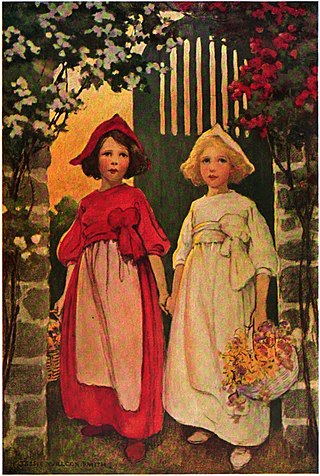
"Snow-White and Rose-Red" is a German fairy tale. The best-known version is the one collected by the Brothers Grimm. An older, somewhat shorter version, "The Ungrateful Dwarf", was written by Caroline Stahl (1776–1837). Indeed, that appears to be the oldest variant; no previous oral version is known, although several have been collected since its publication in 1818. Oral versions are very limited regionally. The tale is of Aarne-Thompson type 426.

"The Golden Goose" is a fairy tale collected by the Brothers Grimm.

Dorothea Viehmann was a German storyteller. Her stories were an important source for the fairy tales collected by the Brothers Grimm. Most of Dorothea Viehmann's tales were published in the second volume of Grimms' Fairy Tales.

Grimms' Fairy Tales, originally known as the Children's and Household Tales, is a German collection of fairy tales by the Grimm brothers or "Brothers Grimm", Jacob and Wilhelm, first published on 20 December 1812. Vol. 1 of the first edition contained 86 stories, which were followed by 70 more tales, numbered consecutively, in the 1st edition, Vol. 2, in 1815. By the seventh edition in 1857, the corpus of tales had expanded to 200 tales and 10 "Children's Legends". It is listed by UNESCO in its Memory of the World Registry.
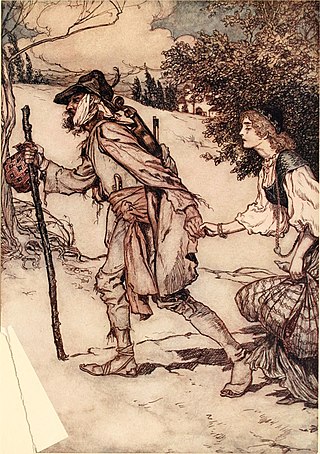
King Thrushbeard is a German fairy tale collected by the Brothers Grimm. It is of Aarne–Thompson type 900.
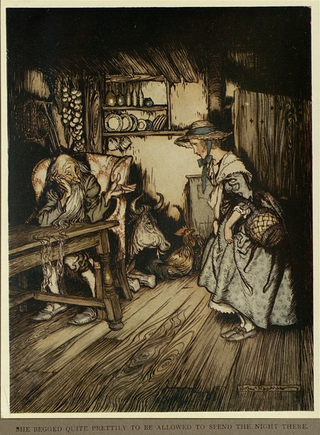
"The Hut in the Forest" is a German fairy tale collected by the Brothers Grimm. Andrew Lang included it in The Pink Fairy Book (1897). It is Aarne-Thompson type 431.
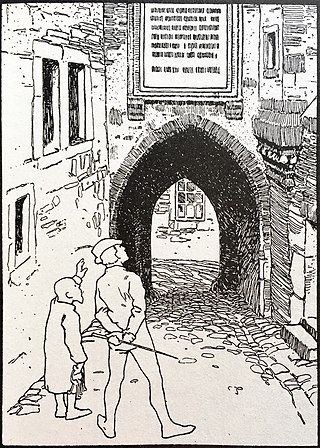
"The Queen Bee" is a German fairy tale collected by the Brothers Grimm in Grimm's Fairy Tales. It is of Aarne-Thompson type 554.
"Thumbling," published in German as "Daumesdick" is a German fairy tale collected by the Brothers Grimm in Grimm's Fairy Tales in 1819. The Grimms included another, similar story, "Thumbling's Travels." Both stories are related to the English Tom Thumb and often share its title when translated into English.
"The Griffin" is a German fairy tale collected by the Brothers Grimm in Grimm's Fairy Tales.
"Old Hildebrand" is an Austrian fairy tale collected by the Brothers Grimm in Grimm's Fairy Tales and written in an Austrian dialect. It is Aarne-Thompson type 1360C.

"The King of the Golden Mountain" is a German fairy tale collected by the Brothers Grimm in Grimm's Fairy Tales.
"The Turnip" is a German fairy tale collected by the Brothers Grimm in Grimm's Fairy Tales.
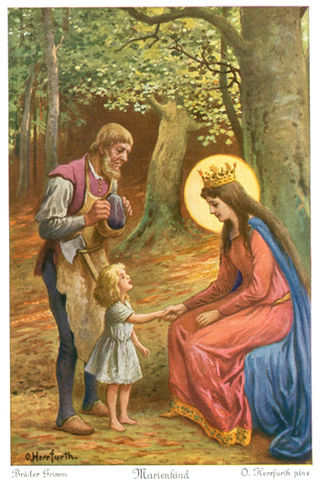
"Mary's Child" is a German fairy tale collected by the Brothers Grimm in Grimm's Fairy Tales in 1812. It is of Aarne-Thompson type 710.
"The Little Peasant" is a German fairy tale collected by the Brothers Grimm in Grimm's Fairy Tales, number 61.
"The Dog and the Sparrow" is a German fairy tale collected by the Brothers Grimm. It is a story of Aarne-Thompson type 248.
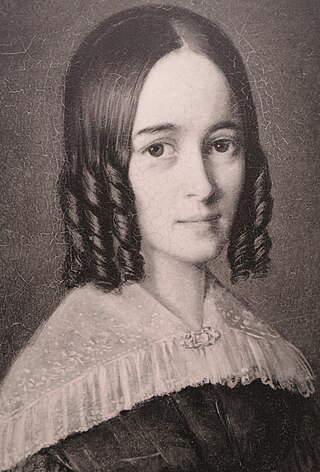
Marie Magdalene Elisabeth Hassenpflug was a German author whose versions of various folk tales were an important source for the collection of tales by the Brothers Grimm. She is best known for her versions of "Little Red Riding Hood" (Rotkäppchen), "Sleeping Beauty" (Dornröschen), and "Snow White" (Schneewittchen).

"The Grave Mound" is a German fairy tale collected by the Brothers Grimm, KHM 195. It is Aarne-Thompson type 779, Divine Rewards and Punishments.

"The Good Bargain" is a German fairy tale collected by the Brothers Grimm, KHM 7. This antisemitic fairytale was added to the Grimms' collection Kinder- und Hausmärchen with the second edition of 1819. It is a tale of Aarne–Thompson type 1642. A similar anti-Semitic tale collected by the Grimms' is The Jew Among Thorns.
Brother Lustig KHM 81 is a lengthy German fairy tale collected by the Brothers Grimm and published in the first edition of Kinder- und Hausmärchen in 1812. It contains elements of Aarne–Thompson type 785: Who Ate the Lamb's Heart?; type 753A: The Unsuccessful Resuscitation; type 330B: The Devil in the Sack; and type 330: Entering Heaven by a Trick.

Gambling Hansel : KHM 82 is a German fairy tale collected by the Brothers Grimm and published in their first edition of Children's and Household Tales in 1812. The story contains elements of Aarne–Thompson type 330A: The Smith's Three Wishes.
References
- ↑ Jacob and Wilheim Grimm, Household Tales, "The Peasant in Heaven"
- ↑ D.L. Ashliman, "The Grimm Brothers' Children's and Household Tales (Grimms' Fairy Tales)"